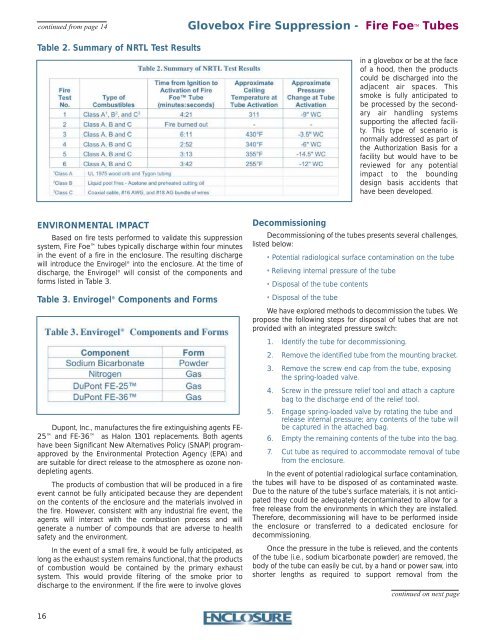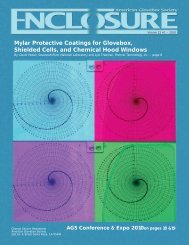Summary and Highlights - American Glovebox Society
Summary and Highlights - American Glovebox Society
Summary and Highlights - American Glovebox Society
You also want an ePaper? Increase the reach of your titles
YUMPU automatically turns print PDFs into web optimized ePapers that Google loves.
continued from page 14<br />
Table 2. <strong>Summary</strong> of NRTL Test Results<br />
ENVIRONMENTAL IMPACT<br />
Based on fire tests performed to validate this suppression<br />
system, Fire Foe tubes typically discharge within four minutes<br />
in the event of a fire in the enclosure. The resulting discharge<br />
will introduce the Envirogel ® into the enclosure. At the time of<br />
discharge, the Envirogel ® will consist of the components <strong>and</strong><br />
forms listed in Table 3.<br />
Table 3. Envirogel ® Components <strong>and</strong> Forms<br />
Dupont, Inc., manufactures the fire extinguishing agents FE-<br />
25 <strong>and</strong> FE-36 as Halon 1301 replacements. Both agents<br />
have been Significant New Alternatives Policy (SNAP) programapproved<br />
by the Environmental Protection Agency (EPA) <strong>and</strong><br />
are suitable for direct release to the atmosphere as ozone nondepleting<br />
agents.<br />
The products of combustion that will be produced in a fire<br />
event cannot be fully anticipated because they are dependent<br />
on the contents of the enclosure <strong>and</strong> the materials involved in<br />
the fire. However, consistent with any industrial fire event, the<br />
agents will interact with the combustion process <strong>and</strong> will<br />
generate a number of compounds that are adverse to health<br />
safety <strong>and</strong> the environment.<br />
In the event of a small fire, it would be fully anticipated, as<br />
long as the exhaust system remains functional, that the products<br />
of combustion would be contained by the primary exhaust<br />
system. This would provide filtering of the smoke prior to<br />
discharge to the environment. If the fire were to involve gloves<br />
16<br />
<strong>Glovebox</strong> Fire Suppression - Fire Foe TM Tubes<br />
in a glovebox or be at the face<br />
of a hood, then the products<br />
could be discharged into the<br />
adjacent air spaces. This<br />
smoke is fully anticipated to<br />
be processed by the secondary<br />
air h<strong>and</strong>ling systems<br />
supporting the affected facility.<br />
This type of scenario is<br />
normally addressed as part of<br />
the Authorization Basis for a<br />
facility but would have to be<br />
reviewed for any potential<br />
impact to the bounding<br />
design basis accidents that<br />
have been developed.<br />
Decommissioning<br />
Decommissioning of the tubes presents several challenges,<br />
listed below:<br />
• Potential radiological surface contamination on the tube<br />
• Relieving internal pressure of the tube<br />
• Disposal of the tube contents<br />
• Disposal of the tube<br />
We have explored methods to decommission the tubes. We<br />
propose the following steps for disposal of tubes that are not<br />
provided with an integrated pressure switch:<br />
1. Identify the tube for decommissioning.<br />
2. Remove the identified tube from the mounting bracket.<br />
3. Remove the screw end cap from the tube, exposing<br />
the spring-loaded valve.<br />
4. Screw in the pressure relief tool <strong>and</strong> attach a capture<br />
bag to the discharge end of the relief tool.<br />
5. Engage spring-loaded valve by rotating the tube <strong>and</strong><br />
release internal pressure; any contents of the tube will<br />
be captured in the attached bag.<br />
6. Empty the remaining contents of the tube into the bag.<br />
7. Cut tube as required to accommodate removal of tube<br />
from the enclosure.<br />
In the event of potential radiological surface contamination,<br />
the tubes will have to be disposed of as contaminated waste.<br />
Due to the nature of the tube’s surface materials, it is not anticipated<br />
they could be adequately decontaminated to allow for a<br />
free release from the environments in which they are installed.<br />
Therefore, decommissioning will have to be performed inside<br />
the enclosure or transferred to a dedicated enclosure for<br />
decommissioning.<br />
Once the pressure in the tube is relieved, <strong>and</strong> the contents<br />
of the tube (i.e., sodium bicarbonate powder) are removed, the<br />
body of the tube can easily be cut, by a h<strong>and</strong> or power saw, into<br />
shorter lengths as required to support removal from the<br />
continued on next page





